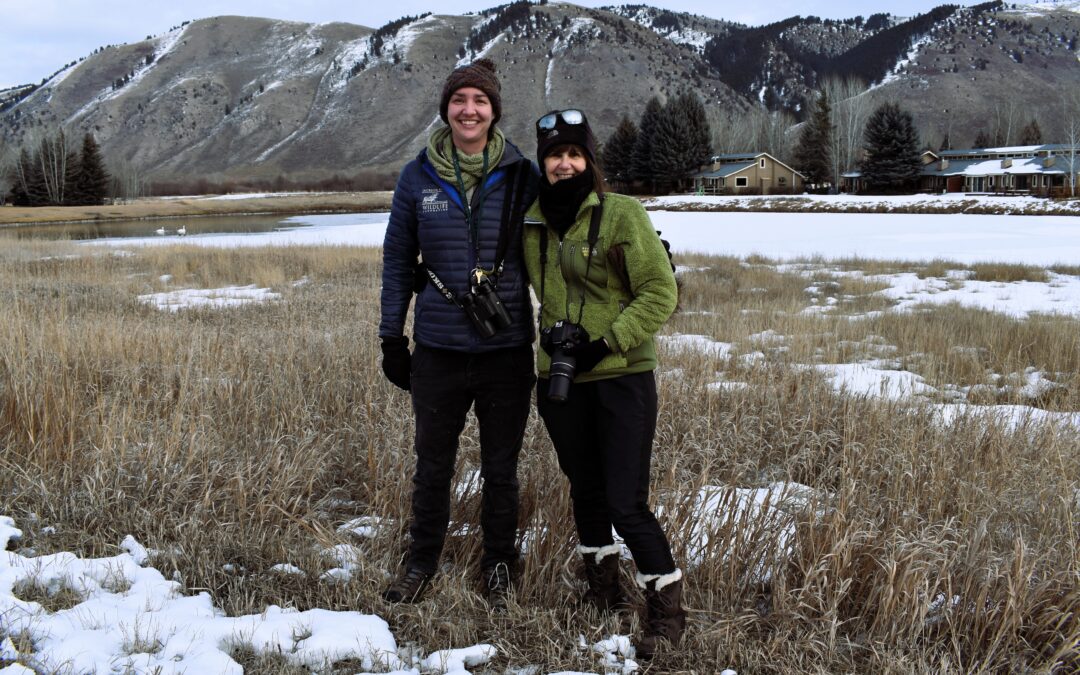
by jhwildlife | Jan 6, 2024 | Blog
By Hilary Turner
The following is a story from Nature Mapping Jackson Hole. Citizen science is valuable because it engages community members in long-term data collection. Through the process of becoming involved in a monitoring project like Nature Mapping JH, folks learn more about their world, while contributing meaningful data that can have a broader impact.
In December of 2021, I received a phone call from a Nature Mapper who lives in the Rafter J Neighborhood. She was wondering if Nature Mapping data showed any strong trends in wildlife use of the area. Unfortunately, there was not enough data in the neighborhood to show any kind of trends, but I encouraged the person to continue Nature Mapping and to have her friends and neighbors email me if they were interested in contributing. So started my friendship with Gina Lipp, a neighbor of the person who had called, who soon reached out with interest in the Nature Mapping program. A resident of Rafter J since 1984 and wildlife enthusiast, Gina wanted to contribute data to further understand how wildlife use the Rafter J Neighborhood.

The Rafter J neighborhood south of Jackson was developed in the 1980s and early 90s. Wildlife corridors through the neighborhood and a thriving Flat Creek riparian habitat have made it a place that many wild animals can call home, alongside their human neighbors.
Gina took my virtual Nature Mapping training in Jan of 2022. About a week after the training, she photographed a Great Gray Owl in the neighborhood, and made one of her first Nature Mapping observations. After this, she reached out to me regularly with questions about the variety of wildlife she was seeing in her neighborhood. She had a camera, so had photos of everything and I was able to help her with identification over email. However, I am a firm believer in the “Teach a person to fish” philosophy, so I offered to meet Gina down at Rafter J and go for a walk to help with some of her bird and wildlife ID questions. As many know, my interest and skill set are geared towards birds, which are one of the most ubiquitous and accessible groups of wildlife, yet relentlessly underappreciated in the Greater Yellowstone Ecosystem (GYE).
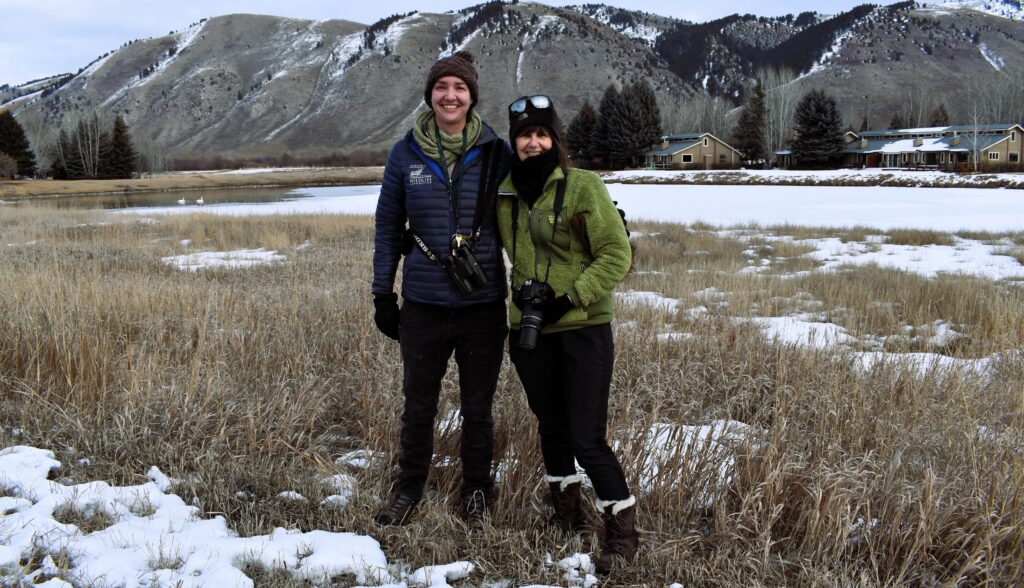
Hilary and Gina began recording Nature Mapping observations in early 2022. Documenting wildlife sightings over a three-mile walking route approximately twice per month, Gina has contributed to citizen-science by making well over 700 wildlife observations in her neighborhood.
I met Gina on a chilly morning in early February of 2022. We started off on our birding walk from the Rafter J office and almost immediately spotted Green-winged Teal in the shallow sloughs of Flat Creek. Farther down the road, some small birds flushed from the ground into the willows. As I lifted my binoculars, a sense of excitement passed over me; the birds were American Tree Sparrows! These adorable songbirds nest in far northern Canada and Alaska and are only present in the GYE during winter. As hardy as they are, they can be very difficult to find during the coldest months of winter in Jackson. Yet here were three individuals, making a living in the Rafter J neighborhood in mid-February. We ended up finding 13 species of birds together that cold morning. Gina Nature Mapped everything we saw and we parted ways, happier for having enjoyed the wildlife in the suburban neighborhood together that morning.
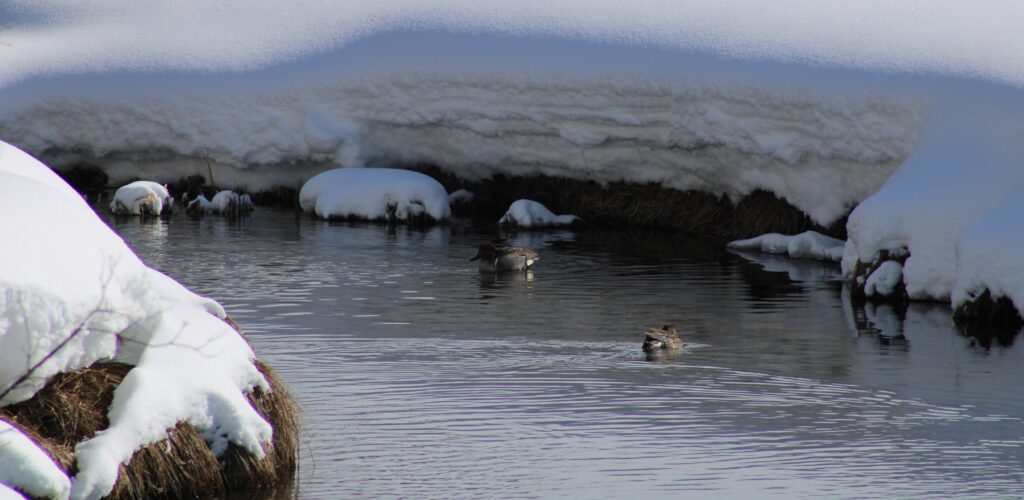
Green-winged Teal photographed on Flat Creek in mid-winter. Green-winged Teal are a dabbling duck found year-round in the Jackson area. Photo: Gina Lipp.
The next year went by and Gina continued to collect data in the neighborhood, but I noticed her reports became fewer and fewer throughout the year. This reduction in reporting is typical with Nature Mappers but I had seen Gina’s enthusiasm and thought if I continued to engage with her, perhaps she would continue reporting. At the start of 2023, I emailed her about the new Nature Mapping app and asked her if she would like to walk again in Rafter J to reinvigorate her Nature Mapping. A clear morning, free of snow, finally arrived and we walked again, this time digging up 18 species. Our list included an American Dipper using Flat Creek and a flock of Bohemian Waxwings relishing the leftover fruit of a crabapple tree in the neighborhood. I told Gina that we should aim to walk again in April, to see what we could find as spring migration got underway. My goal was to understand how birds use the neighborhood during different times of year and I knew Gina was also excited about this.

The local homeowner’s association controls much of the land along Flat Creek through Rafter J, creating a defacto “development setback.” Native vegetation within the riparian zone along the creek allows the area to retain ecological functionality. Birds, mammals (including people!), reptiles, and amphibians all make use of the habitat along the creek.
April came and so did the birds. I was stoked to see what had arrived and to my delight, the Osprey pair were already fixing up their nest for another round of raising chicks atop a platform installed by the neighborhood near Flat Creek. A pair of Northern Harriers coursed low over the open space near the wetland habitat restoration area in the middle of Rafter J. I wondered aloud if they might be breeding in the neighborhood. We spotted eight species of waterfowl using the creek and ponds as stopover habitat during their spring migration. I became ecstatic when I heard a Virginia Rail kiddick-ing from the cattails of the restoration area. A Fox Sparrow sang its glorious tune from the willows along Flat Creek. Tree Swallows investigated nestboxes and I was thrilled to detect five finch species as we meandered through the neighborhood. Our three mile walk yielded an incredible 37 species of birds on April 28. I made plans with Gina to walk again in June, this time to assess the community of breeding birds present in the Rafter J neighborhood.
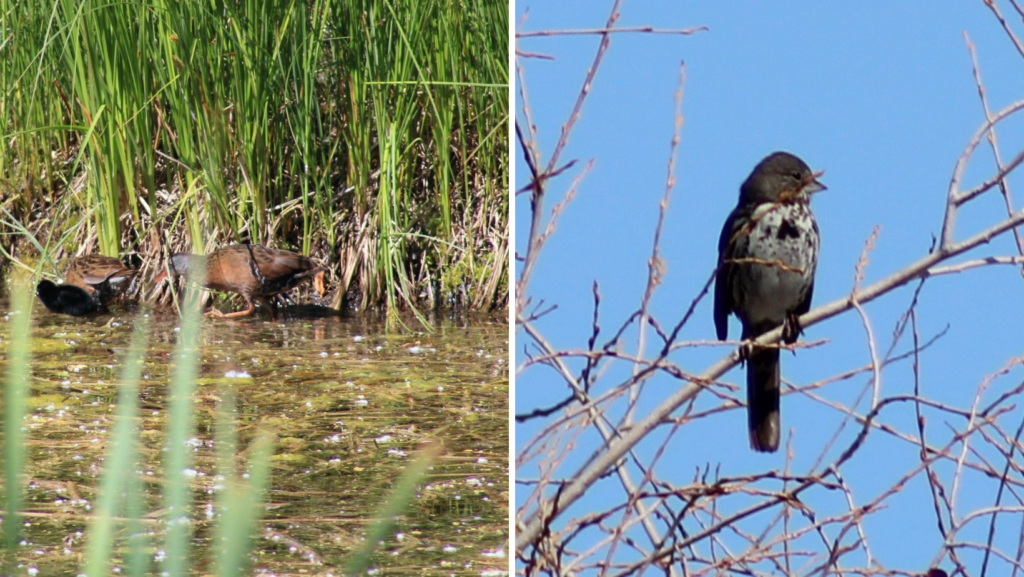
April sightings included elusive Virginia Rails and their chicks (left) in the habitat restoration pond and a Fox Sparrow (right) along the creek. Photos: Gina Lipp.
Gina continued Nature Mapping on her own as well. Everything she reported was easily verifiable with photo documentation. She observed a variety of wildlife using the Flat Creek Corridor and wetland habitat, including beaver, muskrat, moose, coyote and boreal chorus frog. Other members of the neighborhood community became involved as well. Local photographer and JHWF supporter Anna Knaeble became trained in 2023 and mapped Northern river otter and Western toad in Rafter J, both Wyoming Species of Greatest Conservation need and species that are Nature Mapped in relatively low densities in Teton County. Many Rafter J neighbors became excited when a group of White-faced Ibis dropped into a flooded open space of the neighborhood for a few days to refuel during spring migration. The neighbors recognized the importance of the open space in their neighborhood when they observed the birds utilizing it in this way.
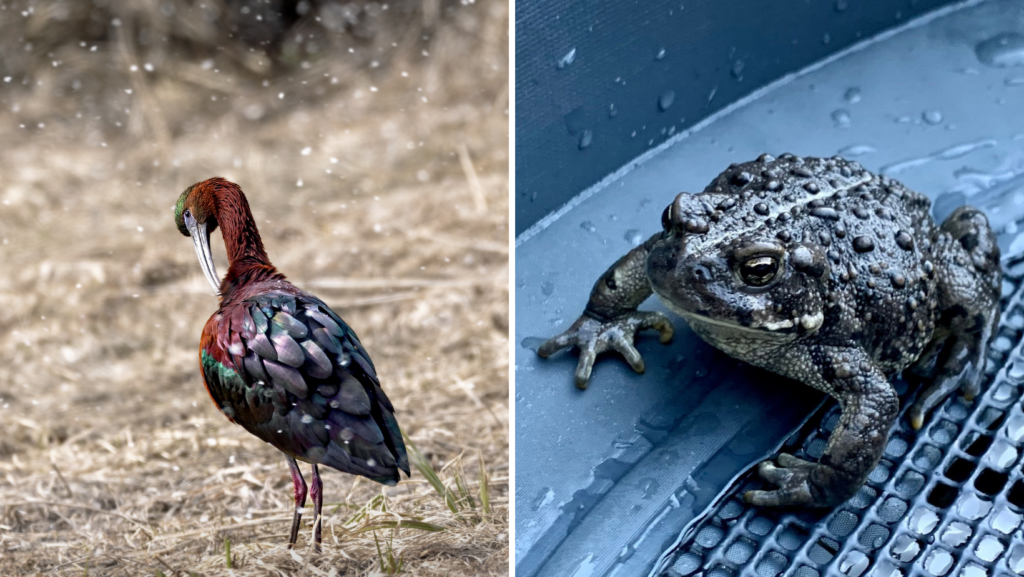
White-faced Ibis and Western toad, both Species of Greatest Conservation Need in Wyoming. Some ibis stopped by to dazzle residents during its spring migration, taking advantage of flooded pasture along Flat Creek near the entrance to Rafter J. Photos: Anna Knaeble.
In June, Gina and I returned to our walking route. Indeed, the avifauna had changed again; the breeding season was now in full swing! The dawn chorus included Savannah Sparrows chiming from the edges of the neighborhood, Black-headed Grosbeaks sweetly serenading from the willows, and Bullock’s Orioles chattering from the tops of residential cottonwoods. Male Calliope Hummingbirds zipped around defending territories with their impressive aerial displays and American Robins carried food to young in nests. Many fewer waterfowl were present, as most had continued their journeys to northern breeding grounds, but we heard another Virginia Rail and Gina spotted a Sora this time. These two rail species do not usually persist outside of intact marsh habitat and their presence during the breeding season is indicative of a functioning wetland ecosystem within the Rafter J neighborhood! Willow Flycatchers sang from the Flat Creek Corridor and we watched a sweet female Yellow Warbler building her nest, low in the willows. We documented 43 bird species on this walk, confirming a robust suite of breeding songbirds in the neighborhood.
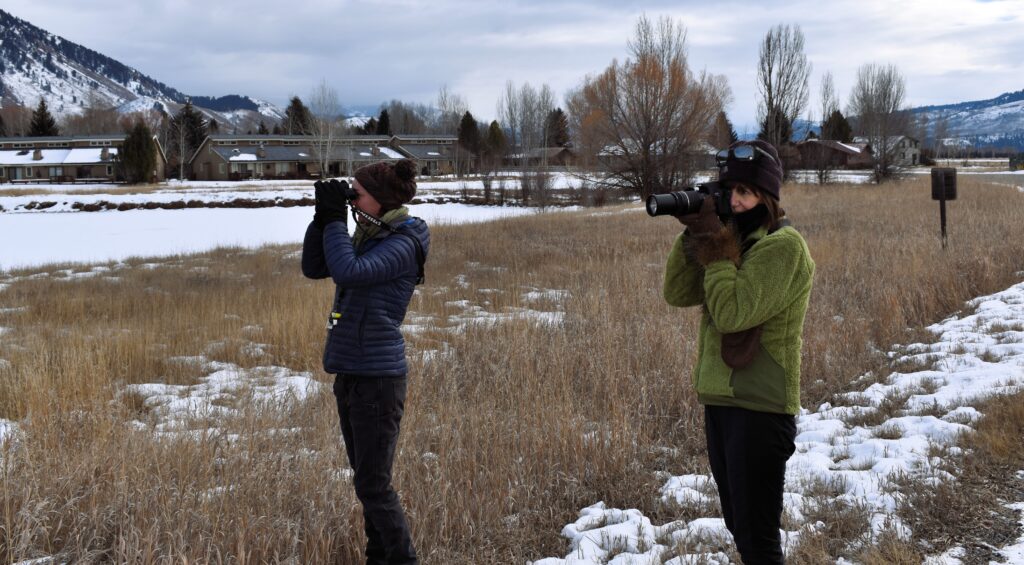
Gina and Hilary watch and photograph waterfowl on a Rafter J pond. This pond is believed to be geothermally heated which keeps portions of it ice-free throughout the winter. Waterfowl such as Trumpeter Swans, Barrow’s Goldeneye, and Mallards make use of the open water.
August rolled around and once again I contacted Gina. This time, I wanted to see what was starting to move south. Fall is my favorite time to go birding in the West and believe it or not, late August is the start of peak fall migration. I knew our walk was going to be great this time. Following the breeding season, there is simply more avian biomass on the landscape and because so many of the birds are young, the likelihood of finding something unusual increases by quite a bit. We met on August 28 and it was foggy to start. Initially, I was bummed at the conditions, but as the sun started to cut through the fog, Rafter J came alive with activity. A Lincoln’s Sparrow skulked in the willows, popping out to allow us brief looks. A Western Wood-Pewee sallied out over Flat Creek, capturing insects and returning to its perch long enough for Gina to photograph it. We encountered six warbler species, a decent number for a single location-outing in Jackson. A Swainson’s Hawk circled overhead, preparing for its annual journey to Argentina. Ruby-crowned Kinglets alerted us to their presence with their chiddit call notes and Cedar Waxwings swirled throughout the neighborhood with their newly fledged young. It was the best outing yet – we detected 54 species throughout the neighborhood that day!
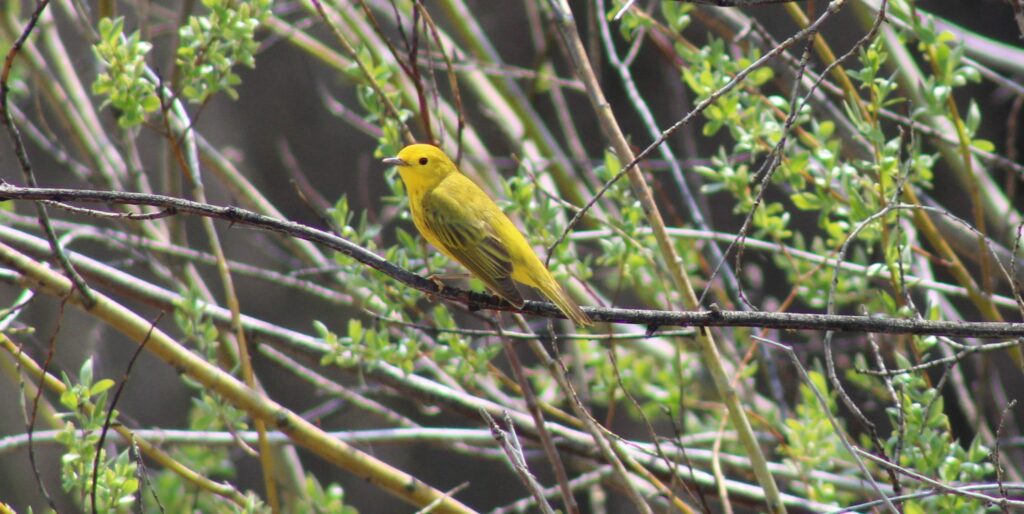
In August, Hilary and Gina record six warbler species on their walk, including this Yellow Warbler. Yellow Warbler is the most common warbler in Jackson during summer months, and can be found without too much work in a variety of habitats, from willows, to wet thickets, to open woodlands. Photo: Gina Lipp.
During our five walks, Gina and I documented a whopping 83 bird species in Rafter J! Even better for me, however, was watching Gina become a keen observer of nature as she grew her knowledge of Jackson’s wildlife. She improved vastly in her wildlife identification skills since our first outing and she also found some amazing things. In mid-July, she witnessed a Virginia Rail emerge from the cattails in the habitat restoration area and then another, followed by two small black fuzzballs – baby Virginia Rails! We suspected they were breeding at the site, but now had ironclad evidence. Since Jan 2022, Gina has made over 700 wildlife observations in her neighborhood. Mapping her three-mile walking route approximately twice per month, her wildlife observations have exact locations, showing where wildlife use the landscape in the neighborhood. Her hard work over the last two years has breathed new life into the Nature Mapping database in the Rafter J neighborhood. Although Gina is dedicated, she is not alone. Since 2016, Rafter J residents have Nature Mapped 118 species in the neighborhood, including 20 Species of Greatest Conservation Need, a state-level designation by Wyoming Game and Fish Department (WSGCN).
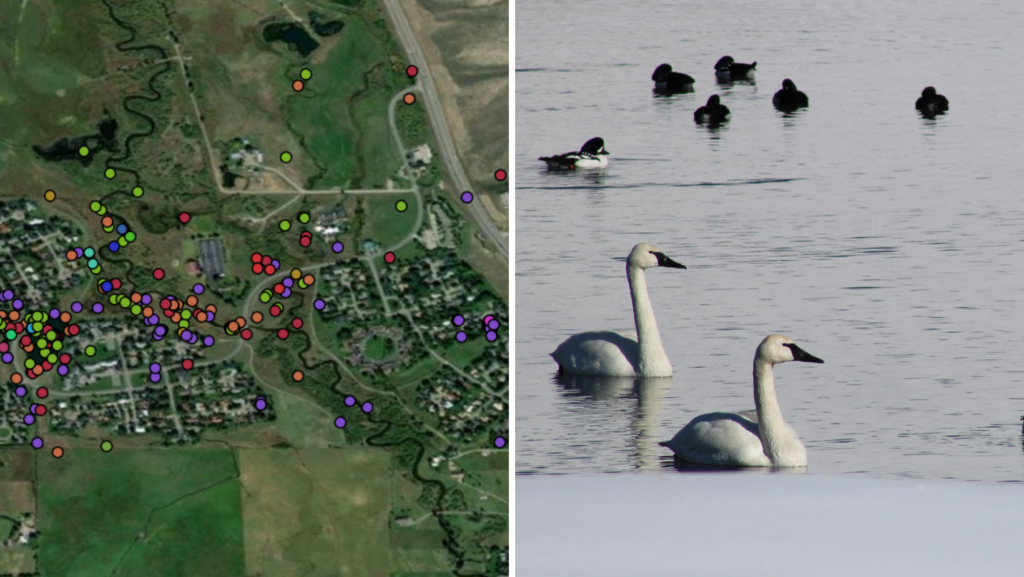
Occurrences of Wyoming Species of Greatest Conservation Need (WSGCN) near Rafter J are shown with colored dots (left). Trumpeter Swans (right) are an example of a WSGCN and utilize the Rafter J pond and nearby wetlands as seasonal habitat and during migration (SEE SWAN SIGHTINGS MAP). Photo: Gina Lipp.
As more development occurs to meet the needs of the growing community, we have a responsibility to consider those who have no voice. Nature Mapping data can give wildlife a voice. The picture we now have of landscape use by wildlife in the Rafter J neighborhood can inform responsible development along Flat Creek, such as Northern South Park, and other areas. Through the data Gina and others have collected in Rafter J, we see that robust development setbacks from Flat Creek and wildlife corridors through the neighborhood have made it a place that many wild animals can call home, alongside their human neighbors. Nature Mapping data show that the neighborhood’s riparian corridor and wetland complex are healthy enough to sustain a very nice suite of riparian breeding songbirds during the summer and make it one of the most bird-rich areas in Jackson Hole in the winter.
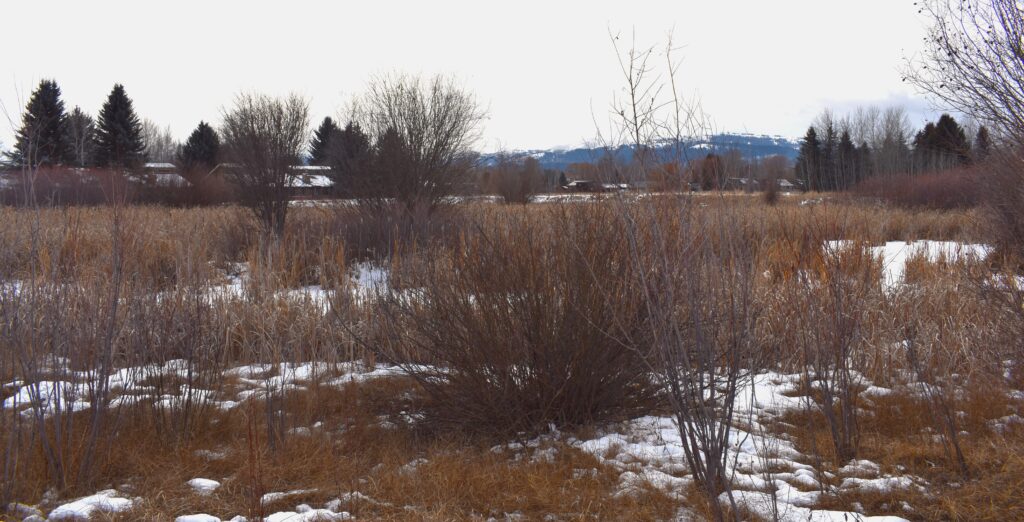
Emergent wetland of the habitat restoration area adjacent to Flat Creek form a valuable habitat type for species like Northern Harrier, Sora, and Virginia Rail, all of which Hilary and Gina spotted here. Sora and Virginia Rail rarely occur outside of intact marsh environments such as this one.
Rafter J residents are fortunate to live alongside such a healthy community of wildlife, but this also comes with the responsibility of stewardship as neighbors to wildlife. Young wild animals are extremely vulnerable to predation by domestic animals like cats and dogs. Keeping cats indoors and leashing dogs while walking through the neighborhood are simple ways to protect the wildlife that also call this space home. Both grizzly and black bears have been documented in Rafter J. Use of bear-resistant trash containers and securing other attractants can be the difference between life or death for these animals. Making conservation-minded decisions, even in a small neighborhood, can have many far-reaching and positive impacts!
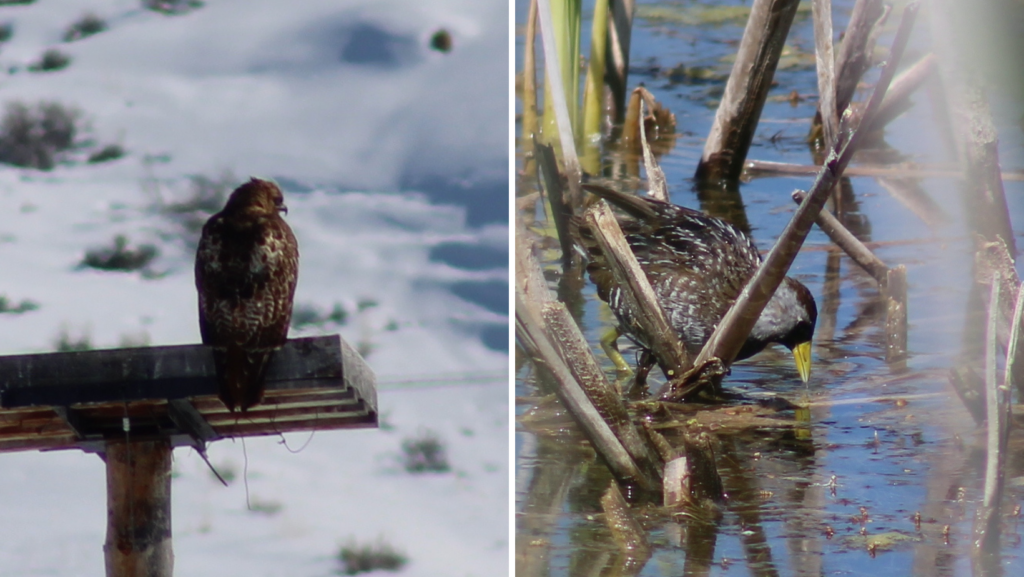
A Red-tailed Hawk perches on a nesting platform on the east side of Rafter J (left). A secretive Sora was a surprise find by Gina in the habitat restoration pond in the summer of 2022. Photos: Gina Lipp.
Gina’s work in the Rafter J neighborhood shows that with commitment and dedication, Nature Mapping can illustrate the complete annual cycle of wildlife – even in developed areas! And if data are rigorously collected, they can sometimes be used to inform responsible development and aid in wildlife conservation.
I asked Gina to speak to the importance of Nature Mapping and this is what she said, “Living in the Greater Yellowstone Ecosystem is a blessing and a responsibility. With all its beautiful wildlife, there is no other place like it in all of North America. Nature Mapping is so important to help us recognize, learn, appreciate, and protect the wildlife and their habitat.”
What will you Nature Map in 2024?

by jhwildlife | Dec 16, 2023 | Blog
By JH Wildlife
What’s in store for Northern South Park
Since 2020, the owners of this land have been engaged with local government and community groups regarding the development of their private property in Northern South Park (NSP). The landowners’ intent is to subdivide and develop a 200+ acre section south of Jackson. An option currently being considered would develop the area densely to accommodate as many as 1,800 housing units (the majority of which would be deed-restricted). Alternatively, the landowners could decide to split the land into 35 acre lots. While exactly how the development plays out is still a bit complicated, what can be expected is the future landscape of NSP is likely to resemble something much different than it does in its current layout of cattle pastures and cottonwood-lined irrigation ditches.

A schematic from the 2022 Neighborhood Plan shows a version of how “passive open space” (light green) might be configured to allow wildlife to move through the development.
How might future development impact wildlife?
Even in scenarios of highest density housing development we anticipate wildlife will use NSP in similar ways to nearby neighborhoods. Although open space will certainly be lost, as agricultural fences come down (including a current 6′ woven and barbed-wire fence which parallels High School Road from the high school to South Park Loop Road) deer and moose will have easier access to the NSP property. New landscaping may increase attractants and potential phasing-out of elk feedgrounds and the termination of elk hazing in NSP may also encourage new movement patterns through the area. Then there’s Flat Creek on the eastern boundary of the proposed development area. Even within the Town of Jackson, Flat Creek serves as an important movement corridor and habitat for everything from beavers, fish and songbirds, to ungulates and other large mammals. Mule deer wintering on the butte across Highway 89 often access this section of Flat Creek for food, water and cover and we expect they will continue to use the creek, even after the buildout of NSP.
So can Northern South Park be developed in a way that reduces the impact on wildlife?
We believe the answer is yes! Currently, Teton County Planning staff are drafting site-specific Land Development Regulations (LDR) and a new zoning overlay in anticipation of NSP buildout. We joined many of our partner organizations in submitting letters to the Planning Commission. While you can read our full letter here, it essentially covers three main recommendations: 1) the application of wildlife-friendly fencing standards, 2) defined Flat Creek setbacks, and 3) protect open space within the developed area to accommodate wildlife movement.
Wildlife-Friendly Fencing Standards: We encouraged the alignment of wildlife-friendly fencing standards in NSP with the current Teton County LDRs to avoid confusion. We also suggested that open spaces and parks remain clear of fencing so as not to entrap wildlife that happens to wander in.
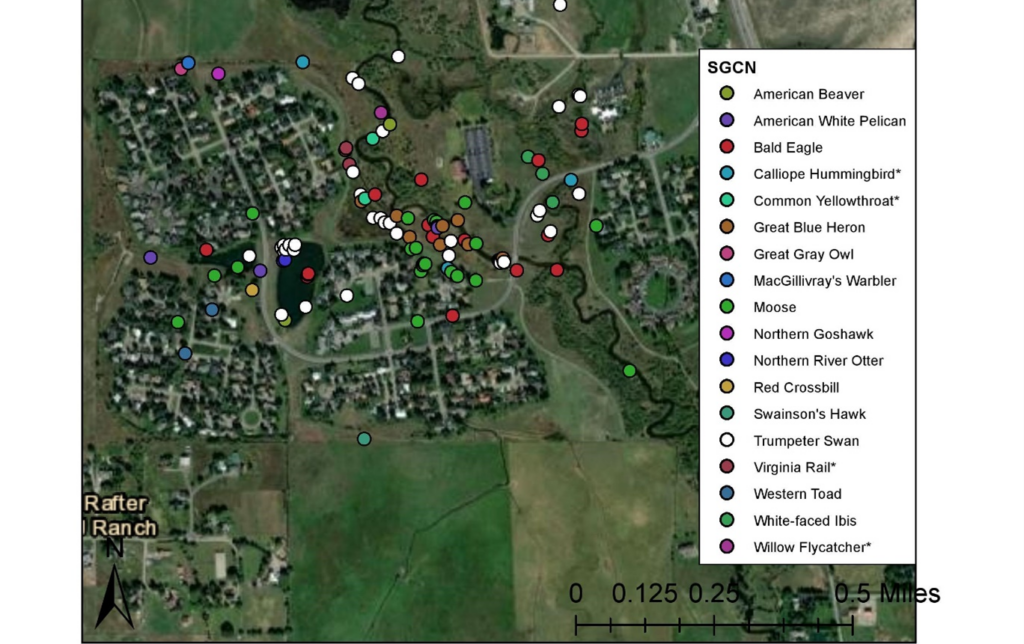
Since 2021, 18 Wyoming Species of Greatest Conservation Need have been reported by JHWF’s Nature Mappers in the Rafter J neighborhood. These data show that the HOA-owned parts of the Flat Creek corridor, as well as the habitat mitigation area, are important for these species. Ideally, NSP would be developed in a similarly responsible way, which would allow for the continued use of the creek corridor by wildlife.
Flat Creek Setbacks: We advised that development not occur within at least 150′ of Flat Creek. A good example of responsible development near Flat Creek is the Rafter J neighborhood. Rafter J’s Flat Creek setbacks, often hundreds of feet in width, are owned and maintained by the Rafter J homeowner association and this protected area supports breeding populations of Wyoming Species of Greatest Conservation Need (WY SGCN) such as Willow Flycatcher and Calliope Hummingbird, along with a large suite of other riparian-associated species. Rafter J also has a habitat mitigation area which supports an impressive community of wetland birds. If NSP can be designed in a similar way, water quality would benefit, as would flood mitigation. This would also help preserve a north to south movement corridor through some of NSPs most valuable habitat.
Open Space: Our recommendation is that NSP design accommodate for wildlife movement through and out of the neighborhood though the preservation of linked, “passive” open space. The NSP Neighborhood Plan, released in 2022, contains sketches of how this open space might be connected and used to allow wildlife passage through the developed area. Ideally, open spaces would maintain a 200-meter minimum width (and larger outside of bottlenecks) based on local research by (Wachob and Smith, 2003). However, if this isn’t practical given the density of the development, these corridors could be combined, to increase width, or laid out near existing open space along the Flat Creek Corridor or southern end of the development area to adjoin with existing open space.

Virginia Rail, another Wyoming Species of Greatest Conservation Need, has been documented breeding in the Rafter J habitat mitigation area. These wetland specialists do not persist outside of intact wetland ecosystems, indicating the health and importance of the Rafter J habitat mitigation area.
If you’re interested in following the development of this issue, the next planning commission meeting is on January 8th! Please let us know if you have any questions or concerns about the process and we’ll answer them to the best of our ability. We are optimistic development can occur in a manner consistent with values outlined in our community’s Comprehensive Plan!
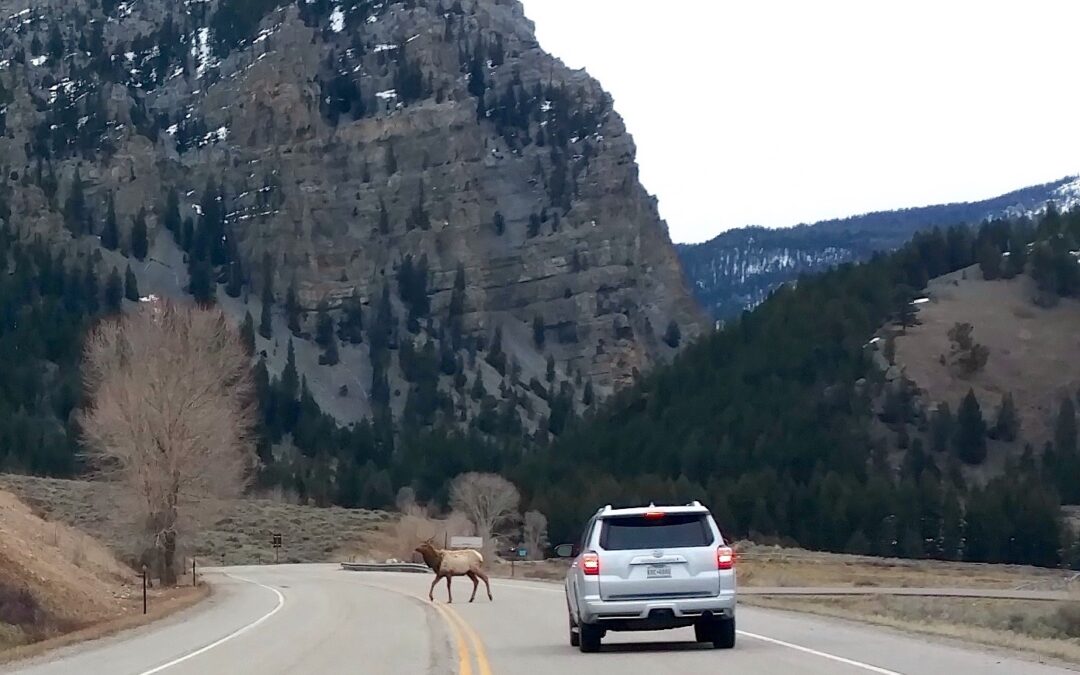
by jhwildlife | Nov 4, 2023 | Blog
By Renee Seidler
Sunday November 5th at 2 am is the end of Daylight Saving Time!
Why do we care?
The end of Daylight Saving Time, an age-old practice that is supposed to give us more waking daylight hours, is the number one worst day for wildlife-vehicle collisions in the US. That may seem odd, so let me explain. Animals (and plants!) are amazing creatures with the ability to adapt to changing environmental conditions (albeit there is almost always a time gap to achieve the greatest adjustment due to the ‘learning curve’). Animals move across the landscape to seek food and water and they move away from threats and hazards. They do this adaptively; for example, mule deer migrate in the spring following a ‘green wave’ of maturing plants as snows melt and temperatures warm, only to repeat the migration in reverse in the fall to find the most accessible winter forage such as on wind-swept or south-facing ridges.
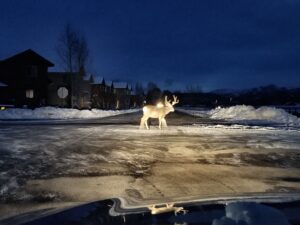
How can you avoid getting into a collision with an animal? Knowing this information is a good start!
These animals adjust their departure time and movements each year to find the best forage. Believe it or not, these animals know our commuting hours! When we are driving through that annoying rush-hour to get home, animals avoid crossing the road as best as they can, even when the resources they need are on the other side of the road. In fact, they are so good at avoiding high density traffic that if there is no relief from high traffic levels, animals will opt to never cross the road, i.e., it becomes a barrier. So, we have conditioned animals to our predictable movement patterns to protect their own lives by crossing roads when we are less likely to be driving the road.
Then along comes Daylight Saving and we are not predictable anymore. In the fall, the end of Daylight Saving means we are suddenly driving home on weekdays one hour earlier than usual. Compound that with animals attempting to avoid hunters (which further distracts animals), seek mates during the rut/breeding season (even more distraction), migrate to more favorable climes for the winter, navigate shorter days, and you have quite a perfect storm that can spell out more animals on the road at the ‘wrong time.’ This results in more wildlife-vehicle collisions in the fall, especially starting with the end of Daylight Saving.
How can you avoid getting into a collision with an animal? Knowing this information is a good start! It is proven that being more attentive (e.g., don’t use your phone), driving the speed limit (because it makes it harder to stop before you hit the animal in the road), expecting more critters to cross the road when you see just one, knowing where animals are more likely to cross the road such as at stream crossings or migration routes (look for the road signs!), and helping warn other drivers of hazards by using your flashers when animals are in the road.

by jhwildlife | Sep 14, 2023 | Blog
By Kole Stewart – Bear Wise Jackson Hole Program Manager
It’s been a busy summer for the Bear Wise Jackson Hole (BWJH) partnership.
In the last few months alone, BWJH has had the opportunity to attend over a dozen events aimed at reducing human-bear conflict in Teton County, including charging bear and bear spray deployment demonstrations and education presentations. The BWJH partnership has also played an important role in coordinating outreach efforts around the valley.
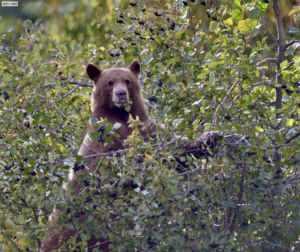 The follow are some of BWJH’s major successes this summer:
The follow are some of BWJH’s major successes this summer:
- 520 people trained on the proper use of bear spray using the “charging bear demonstration”.
- 13 events attended this spring/summer (e.g. Ecofair, Old Bills, HOA meetings, presentations) with approximately 4500 participants. BWJH provided education on coexisting with wild bears at these events. If you’d like to have us present at your HOA, please let us know!
- BWJH assisted in distributing more than 120 cans of free bear spray to participants (hunters, hiking groups) at select events.
- The partnership reached thousands of Teton County residents through bulk mailings, fliers, presentations and advertisements on local radio.
So are our efforts paying off?
While we still have a ways to go, we’re pleased to report that portions of Teton County that have been under garbage-storage regulations for more than a decade are now approximately 98% compliant, while areas new to regulations are approximately 80% compliant. We estimate areas within the newer Town of Jackson “Bear Conflict Zone” are already close to 70% compliant.
We view these numbers as a major step in the right direction. They show substantial increases from much lower compliance rates earlier this spring. We’d like to thank our community for stepping up to reduce the potential for bear-human conflicts in the Jackson Hole area!

by jhwildlife | Aug 24, 2023 | Blog
By Hilary Turner
Fall is the best time to observe shorebirds in the Greater Yellowstone Ecosystem. A few locally breeding species are present during summer, such as the ubiquitous Spotted Sandpiper, the vociferous Killdeer, and grassland obligate Long-billed Curlew; however, many members of this specialized group were in the high Arctic for the summer and are now headed south toward coastal and neotropical destinations.

American Avocets are among the most visually striking shorebirds and also the easiest to identify, even in non-breeding plumage.
Jackson Lake Dam can be a stellar place to observe shorebirds during July-October, with its sometimes-extensive mudflats. South Park WHMA can also provide good shorebird habitat, depending on water levels, and sand bars and shorelines of the Snake River can also harbor migrants during the fall.
Tringa sandpipers are among the earliest migrants we encounter in the Tetons. Whether failed breeders or northbound migrants that didn’t complete the journey, the large and stately Greater Yellowlegs can appear in the GYE as early as late June. Solitary Sandpipers and Lesser Yellowlegs are smaller members of the genus that arrive slightly later and increase in number throughout the early fall.
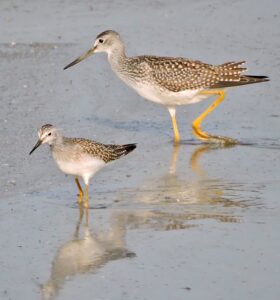
Greater and Lesser Yellowlegs by Dan Casey
Check for them wading along sloughs and other small, shallow bodies of water. In non-breeding plumage, the Solitary Sandpiper can look similar to the Spotted Sandpiper. To distinguish them, notice the white spots on the back and wings of the Solitary, as well as its complete white eye ring.
Calidris sandpipers are some of the smallest shorebirds that move through this area. Species like Least, Western, and Semipalmated Sandpipers move through Teton County each fall, utilizing mudflats, sand bars, and floating vegetation mats as habitat while they refuel for their long journeys. Identification is difficult, but paying attention to shape, size, leg color, and foraging strategy is often more helpful than examining plumage characteristics.
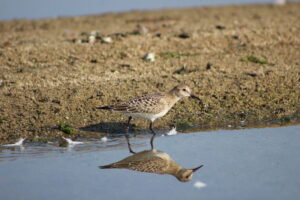
Baird’s Sandpiper. Note the golden hue and scalloped back.
The slightly larger Baird’s Sandpiper is truly impressive. Its elongated wings, specialized to take it across continents, are diagnostic in its identification, as well as its golden hue and scalloped back. Some Baird’s Sandpipers, after breeding on Alaska’s North Slope, may travel to the southern tip of South America in a little more than a month.
Dowitchers are long-billed shorebirds that travel from the high arctic to wintering grounds in the southern United States and Mexico. Long-billed Dowitchers are frequently seen during migration in the GYE, but Short-billed Dowitchers can also be detected by a skilled observer.
Juvenile birds are more easily distinguished visually by plumage characteristics than adults, but the best way to identify them is by their different flight calls. Bill length is an unreliable characteristic; while female Long-billed Dowitchers do indeed have longer bills than female Short-billed, there is plenty of overlap in male bill length.
Stilts and Avocets are tall, striking shorebirds and unlike some members of this group, easy to identify.
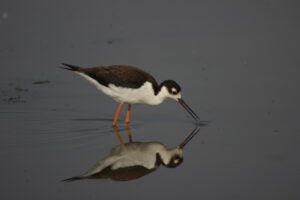
Black-necked Stilt
The Black-necked Stilt has the longest legs relative to its body size of any bird in Wyoming and the American Avocet has a long, strongly recurved bill that is also unique. Both also have distinct plumage patterns, although the avocet loses its cinnamon head color in the fall. Stilts and avocets are sometimes found in deeper water than other shorebirds, with avocets frequently swimming in water that is too deep for wading.
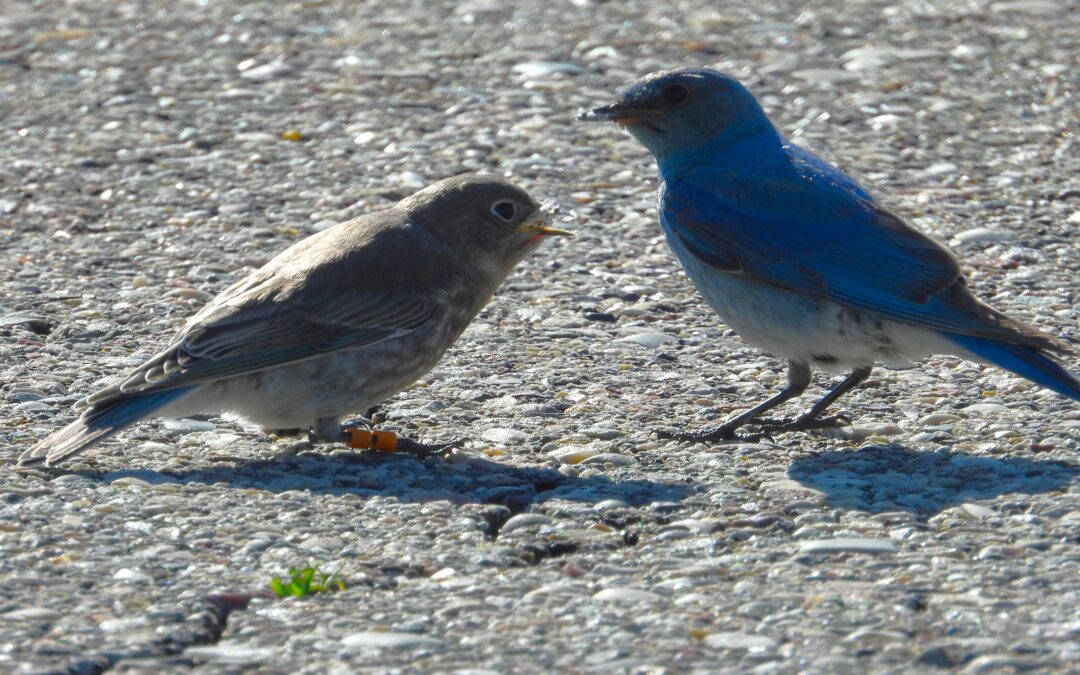
by jhwildlife | Jul 4, 2023 | Blog
By Kyle and Vicki
What purpose does our nestbox trail serve?
Mountain bluebirds are a cavity nesting species which rely mainly on holes in trees, often created by woodpeckers, to raise their young. This species of bluebird is believed to be on the decline in the West due to factors such as habitat loss and competition for limited cavity nests from invasive species like house sparrows and European starlings.
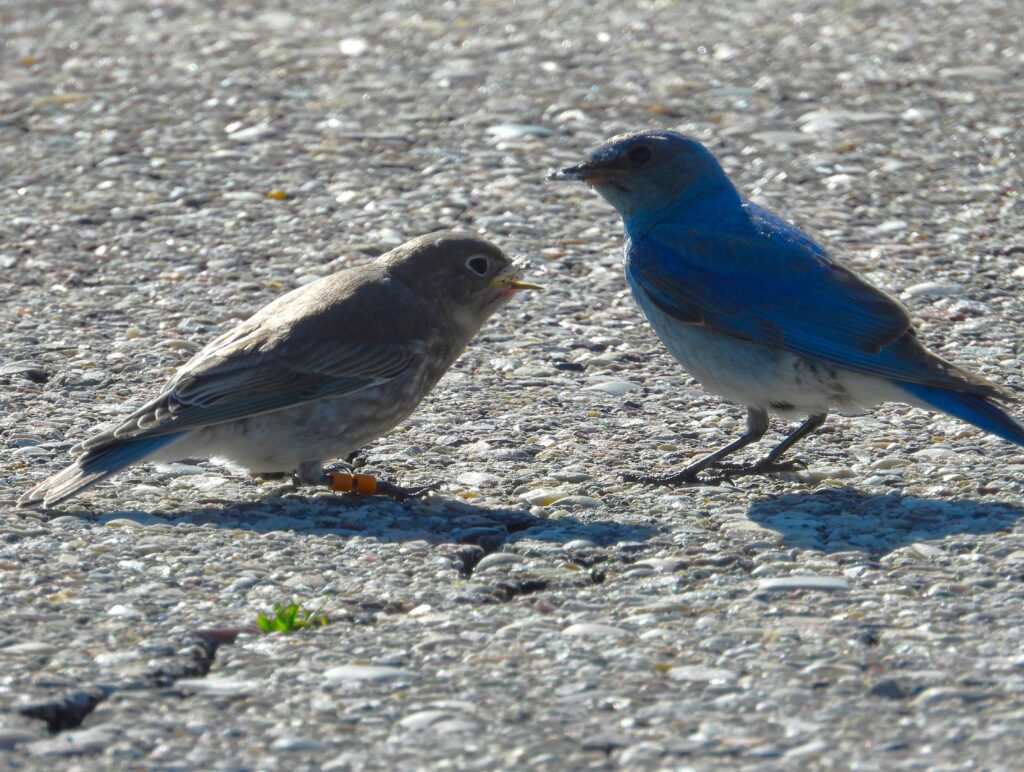
A fledgling bluebird from box 44 is fed by an adult on Monday at the Fish Hatchery. Photo Vicki Morgan.
Mountain bluebirds are among the first nesting songbirds to return to the Jackson Hole area each spring. There is likely some evolutionary strategy at play here; by returning when the ground is largely still snow covered bluebirds risk exposure to lack of food and cold temperatures, but gain an advantage over rival species when it comes to snagging limited nesting sites.
Our trail of volunteer-built nestboxes on the National Elk Refuge’s western boundary not only provides bluebirds with much needed nesting locations, but allows scientists a chance to gain a more complete understanding of the overall health of this sub-population.
How are the bluebirds faring this spring?
Overall, we’re confident 2023 has been a good year for bluebirds. While we won’t have a full dataset until the end of the summer, reports from our banding team and volunteers indicate bluebirds both returned to the trail and nested in relatively high numbers this spring.
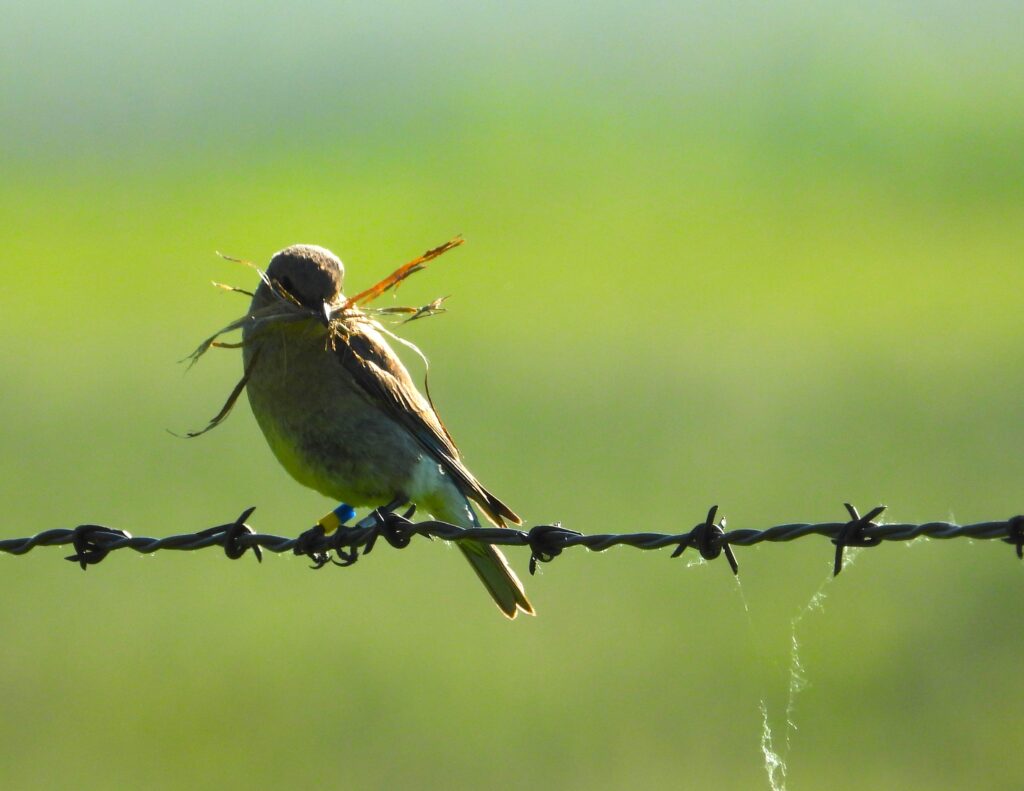
While spring conditions imperiled some nestlings early in the season, wet conditions are likely to foster increased numbers of insects later in the summer which may benefit second rounds of nests. Photo: Vicki Morgan.
At one point, 16 active nests were recorded, more than were active over the entirety of last season. According to Lead Bird Bander Vicki Morgan, who surveys boxes and organizes volunteer data weekly, there are currently two to three boxes with nestlings about to fledge, and between four and six boxes where bluebirds are on their second attempts at nest building.
Several fledglings from box 44 were even “hanging out” at the Fish Hatchery parking lot, where they were being fed by their parents as of Monday morning (don’t all go to photograph them at once!).
The success of nestboxes this year can at least partially be attributed to last year’s batch of fledglings. At least four nest boxes contain female bluebirds which were banded last year as chicks. These birds migrated away last winter and have since completed successful return journeys back to the National Elk Refuge to build their own nests, usually within hundreds of meters from where they themselves hatched. The fancy phrase for this is “site fidelity.”
What are the challenges facing this year’s nesters?
Still, bluebirds on the nest box trail have faced challenges in 2023. While nest building jumped off to a quick start, insects were slow to emerge due to late-spring weather patterns and a handful of nests failed with a lack of available food for nestlings. While nest failure is a natural and normal process, it doesn’t mean it can’t be frustrating to witness young birds not make it, especially when you’re rooting for team bluebird! Several of our boxes have also experienced predation in recent weeks. Our best guess is that weasels are the culprit – snakes can also fit through nest box holes but generally devour young birds whole. Weasels on the other hand are prone to leaving behind “nestling bits” as evidence of their transgressions.
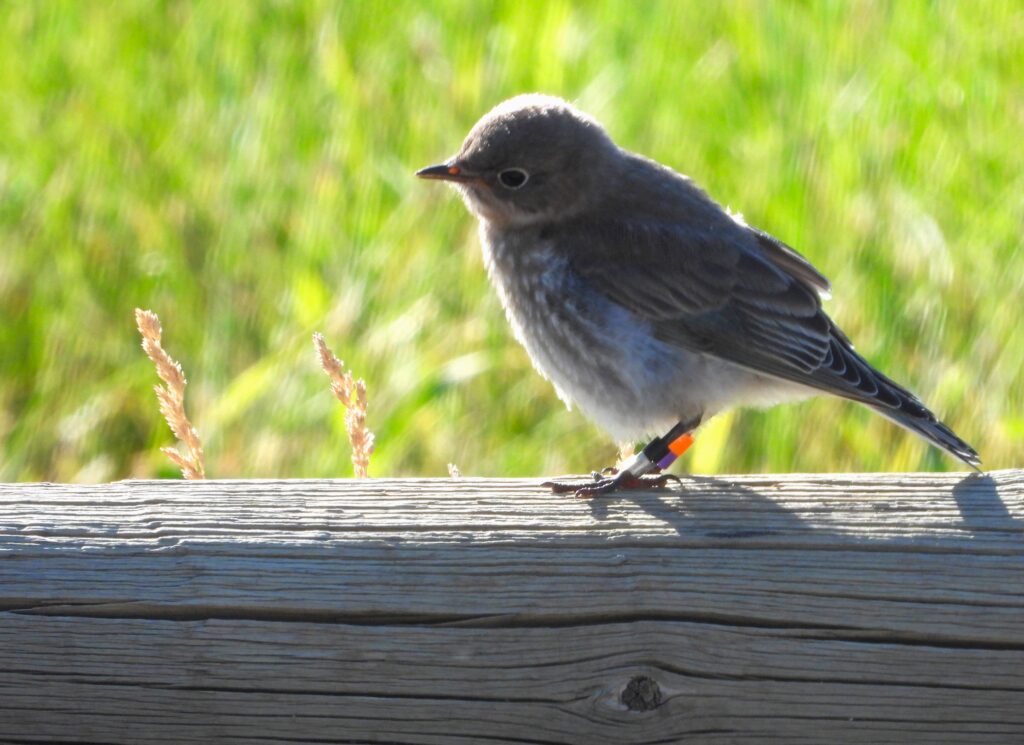
A 2023 fledgling with this year’s diagnostic color-band combination. Photo: Vicki Morgan
Are the nestboxes helpful for the birds?
We believe they are. Although not all nestling birds survive (you’re welcome weasels – for the buffet), the fact that many bluebirds do successfully fledge indicates the Mountain Bluebird Nestbox Project is likely having a net positive effect. Two years ago, a bird banded on our trail was recaptured and released in Texas during winter migration. And each year more and more “resights” of birds banded in previous years pour in. It’s going to take more than one productive year to help ensure the longevity of this species in our region, but that doesn’t mean we can’t get excited about this season’s results!



















 The follow are some of BWJH’s major successes this summer:
The follow are some of BWJH’s major successes this summer:







